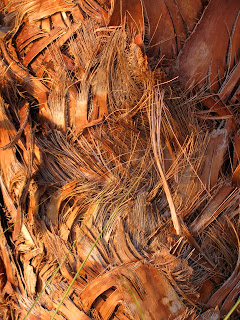Whenever we are in Florida, I am always on the lookout for birds, flowers, and wildlife. We have now made several trips, so once exotic species, such as the anhinga, or sea oats, are no longer new although I'm always thrilled to see creatures we don't see at home. By April, all of the wild swans in our area have migrated away from the refuges along the Mississippi for nests in the north. I can't find wild swans listed in my Florida bird books at all. But on Sunday after church we went to Coconut Point for lunch and shopping, and I spied a pair of graceful, tame swans on the lake in the shopping center.
While I was stalking the swan, I heard a lot of chattering and singing in a small tree next to the parking lot. This common grackle was singing to another one perched on a branch above, apparently in a courtship display. It didn't seem bothered by my camera or me in such close proximity. It had other things on its mind.
Many tropical and semi-tropical flowers grow on the beautiful grounds around the condo where Doug and Matt live. We took a sunset walk almost every evening to look for dolphins and on one evening this hibiscus was catching the last golden rays of the sun as it sank across the water.
Sea Grape is ubiquitous in Southwest Florida. It grows wild along beaches and it also is used as an ornamental hedge on residential and commercial property. Mature plants bear a grape like fruit in the fall that I read is used to make jam. Never have tried it.
The setting sun turned the trunks of the palms lining the walk along the river to a rusty gold. The fibers are not a true bark. The trunk of a palm, I have read, grows as large as it is going to be before the tree starts to grow vertically. Palms don't have true wood or bark, but the fibers look like they might be useful. I was attracted by the texture, and compared it to the trunk of the native pines, like the one in the next picture.
A contrasting texture is evident on the trunk of the slash pine, common in the Florida flatwoods. This one was growing at the Calusa Nature Center where we went one afternoon to walk a nature trail boardwalk through the woods and swamp, but the swamp was dry.. the rainy season is from around June to November, and this was April. Southwest Florida was also having a dry year. The plates of the bark are scaly and sometimes peel away, kind of like birch bark.
We had visited the Calusa Nature Center once before, in September 2006. (Here is a link to that post.) We went back to see what creatures might be stirring in April, since our previous visit had been in the wet season. It was a humid, sunny afternoon and very little was stirring, so we just enjoyed a quiet walk, just yards away from one of the very busy streets of Ft. Myers.
It was straw hat and and sunscreen weather on this afternoon, though. For some reason Norm kept taking pictures of me. Maybe it was the novelty that I could walk 1.5 miles without passing out or limping!
Despite visits to several wildlife areas in Florida, we had never seen an alligator in the wild. We still haven't, but this male 'gator and his pregnant mate were residing in a pond, behind a chain link fence, at the Calusa Nature Center. He kept on taking his nap while we got as close as possible from above on a walkway to take his picture. Or maybe he was just pretending, hoping we might fall overboard.
The only other creatures we saw moving were small lizards, or anoles, on the boardwalk. This is a brown anole, a species introduced from Cuba. The male has a very flashy orange throat pouch which we saw, but didn't capture it on camera. These reptiles are out-competing the native Florida green anole, a species that is declining. They eat insects and are not poisonous.
Despite the dryness, deep in the forest a bed of ferns was lush and green, still tapping into moisture that had once been a pond. The light plays on the leaves and creates a cool scene on a warm day.
As we left the center to go back to the condo, we saw a bush outside the front entrance covered with these bright coral blooms that were covered by the yellow butterflies. I haven't been able to find the flowers in my handbooks, so I am assuming they are a cultivated species and not a wildflower. They certainly resemble a honeysuckle. The butterflies were a vivid yellow, and insisted on resting in this posture, rather than spreading their wings. They seem to be one of the sulphur butterfly species, possibly the rather inelegantly named Southern Dogface, although they seemed as large as the Cloudless Sulfurs. Clearly I need to brush up on my Lepidoptera!
One major Florida habitat we have not explored is the Everglades. We hope that on a future trip, which will have to be in winter, we can drive down to Everglades National Park south of Naples and perhaps go on an airboat ride for a guided tour. We also are looking forward to a boat ride along the coast of the Gulf of Mexico to explore the mango hammocks and other features there.
Let’s Go Around the Table (in Detail)
1 week ago





















1 comment:
Thanks for the botanical travelogue! Love the photos and the way you do these photo essays. We're off to Sedona, Arizona next week, and I may steal your style here...
Post a Comment